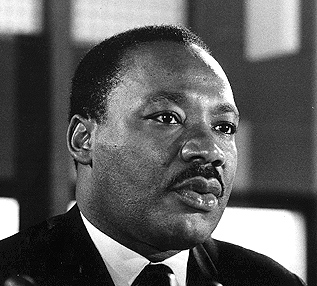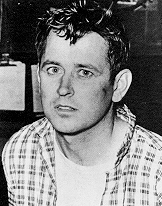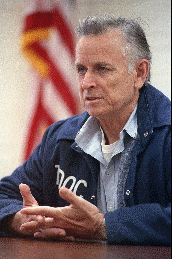

JAMES EARL RAY


When James Earl Ray was arrested for the murder of Dr. Martin Luther King, Jr., he was 40 years old. Born on March 10, 1928, to working-class parents in Alton, Illinois, on the Illinois-Missouri border, he was the first of nine children. The Depression era poverty and suffering left its mark on the family, but according to Ray's autobiography, they were not unhappy and did regular things, like going fishing with their father or to a ballgame. What was unusual about his family however, was the tendency of his father and uncles to choose life outside the law when the opportunity arose. In fact, throughout his young life his father, an escapee from Fort Madison Prison in Iowa, often made decisions for the family on the basis of his trying to remain inconspicuous. For example, when one uncle became involved in forgery scheme, the family moved and changed their name. Ray attended first grade (for the first time) as James Rayns. Ray's life was one of continual stonewalls--beginning with repeating 1st grade (under two different names). When he was in the 8th grade he quit school forever.
Ray seemed to favor life outside the law--which proved time and again to not be a good choice for such an unlucky person. Thus went his life. After a few attempts at honest labor, he did a stint in the army where he served in occupied Germany and learned how to supplement his income with illegal activities. An AWOL charge resulted in three months in the stockade and a discharge "under honorable conditions." Following his return to the States he took to stealing as an occupation. He was not very effective at this either, racking up a record of "bungled and ludicrously inept robberies and burglaries." Both the thefts and the ineptness could be traced to the propensity for alcohol that would eventually kill him. However, although he tended toward armed robbery, he never showed any record of violent crimes. He served time in prison for stealing on four separate occasions. He considered himself, in the family tradition, among that class of, as he put it, "professional criminals convicted of robbery, burglary and so on, for whom getting caught and doing time was a cost of doing business." The last of these, a $120 theft from a cash register, netted him a 20-year sentence in the Missouri State Penitentiary, branded as a habitual criminal. But he was clever, plucky, and able to bounce back easily. After two successful escape attempts, he had a stroke of good luck and managed to ride a delivery truck to freedom on April 23, 1967, packed under 60 loaves of prison-baked bread.
The story of Ray's arrest and conviction for the murder of Civil Rights leader Martin Luther King is a familiar one to every American by this point. He was in the right place at the right time, but continued to his deathbed to maintain that he was put there by a mysterious Raoul, and that he did not pull the trigger. And even if he did pull the trigger, what could his motive have been, if it was not a contract killing? Acting on his own, certainly he had every motive to avoid trouble, free for the first time in many years, with enough money to last a good while, thanks perhaps to the unsolved bank robbery in Alton, Illinois. In addition, the uncharacteristically well organized and executed escape was marred only by the characteristic type of blundering that had gained Ray so much prison time in the past. There are many unanswered questions.
In the final days of Ray's life, the King family came out as a supporter of his bid for a trial. His guilty plea had deprived him of the day in court that might have cleared up many mysteries. It's another one of those '60s assassinations of which many people, not just conspiracy buffs, would like to see a fuller investigation. Ballistics tests did NOT result in a match between bullets fired from the alleged assassin's rifle and slugs that were supposedly removed from MLK's body in 1968. Authorities in Tennessee have since been able to remove judge Joe Brown from the case (most likely because he had an open mind about a possible conspiracy). When James Earl Ray died, all possibility for a trial ended. However, a civil suit has been brought by the King and Ray families that returned a decision that there WAS a conspiracy in the murder of MLK. Former Attorney General Janet Reno initiated an investigation into new conspiratorial claims concerning the assassination.
Sources: Ray's story is told in his book, Who Killed Martin Luther King? The True Story by the Alleged Assassin.JAMES EARL RAY WEBSITE
This site, from Fair Play Magazine & the JFKLancer Website contains
complete information on the ongoing efforts to clear Ray's name as King's
assassin.
